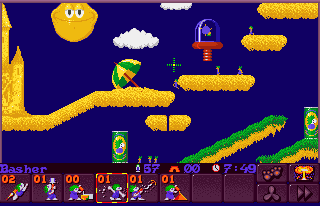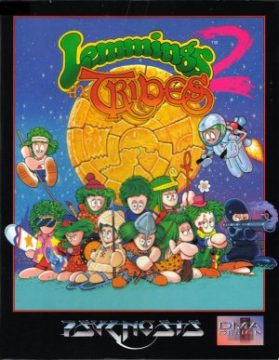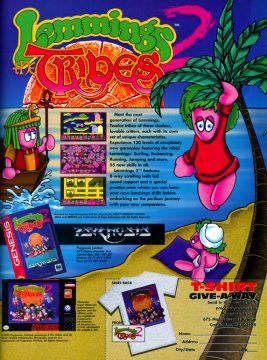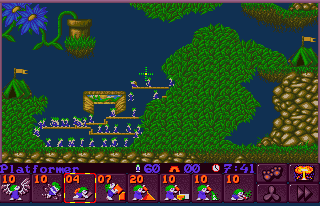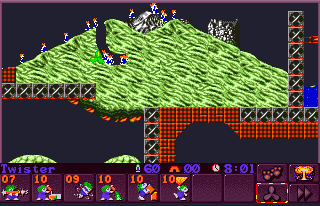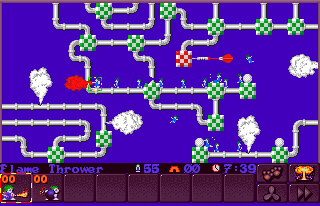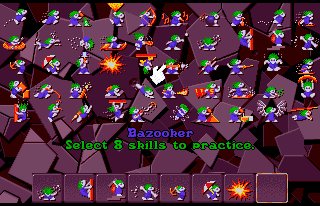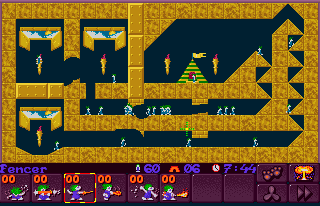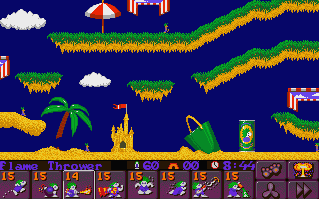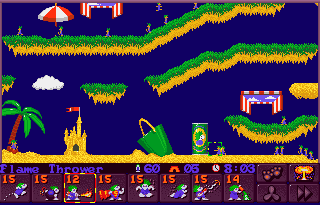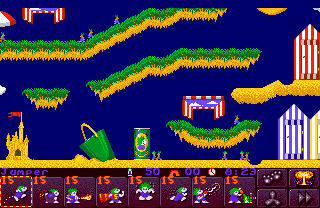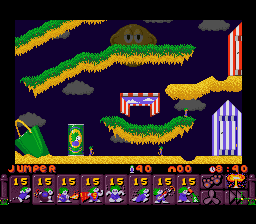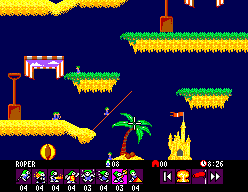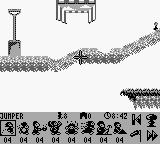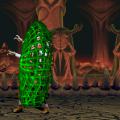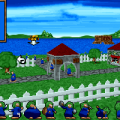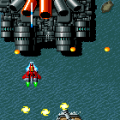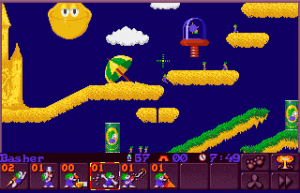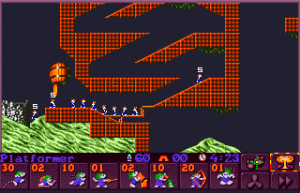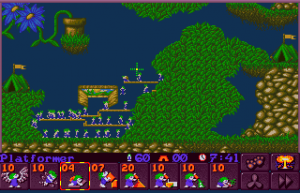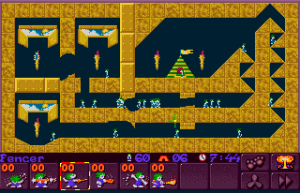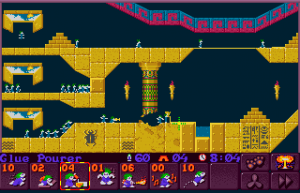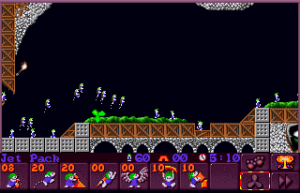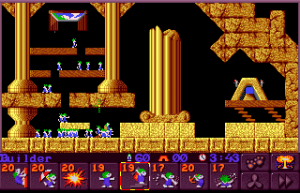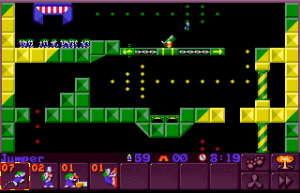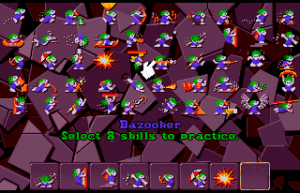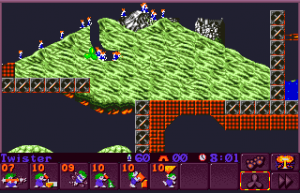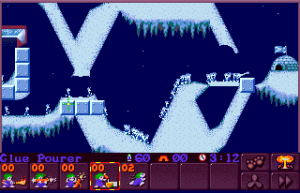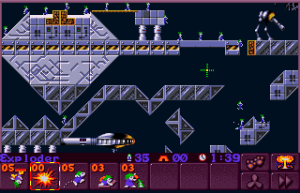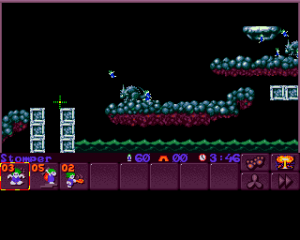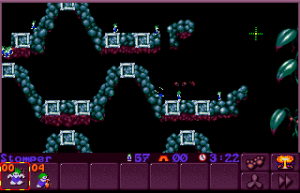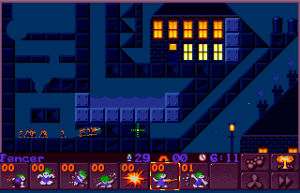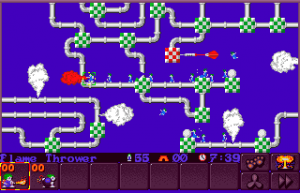Long after the events of the original Lemmings, the little creatures have finally settled into a permanent home. The lemmings have split themselves into 12 tribes across the land, each holding a piece of a powerful medallion. Unfortunately, a prophecy speaks of a great darkness, and the whole medallion is needed to build an ark for the lemmings to escape it. All 12 tribes will need the help of the same guiding force who brought them to safety so long ago, and that would be you. If you weren’t a total bastard that made them blow up several dozen times, of course.
Is any of this plot strictly necessary? Not really. None of it shows up in the actual game itself, and it’s only mentioned because this time around there’s a three and a half minute long animated intro. There’s been a lot of work in the presentation this time around, and it really helps.
Lemmings 2 has had a lot of changes from its predecessor, and they all help make the game a smoother, more fun experience. Unlike Oh No! More Lemmings, there are some pretty major gameplay changes this time around.
Instead of having levels split into difficulties, you get a map screen that lets you select the tribe you want to play as. Each tribe has 60 lemmings and 10 levels to guide them through, and lemmings that make it to the exit will carry on to the next stage. Technically, only one lemming has to reach the goal to open the next level, but every level needs the teamwork of several lemmings to complete. Depending on just how many lemmings you save on each level, you’ll earn a bronze, silver, or gold medal. You’ll need all the gold medals, and have at least 20 lemmings saved at the end of the tribe to get the ending. If you don’t have enough lemmings for a level, later down the line, you’ll have to go back and replay, hopefully doing better this time.
The tribes play pretty much identically. Aside from Scottish lemmings, ninja lemmings, space lemmings, and cave lemmings, among eight others, there’s also a classic tribe that’s so classic, they aren’t even subject to the new gameplay changes the other classes have. Since levels are no longer sorted by difficulty, the difficulty curve is a bit uneven, although some tribes have generally easier levels than others.
The biggest change is that, instead of just eight powers available for your lemmings to use, there are a staggering total of 50. Thankfully, the game doesn’t actually give you all 50 each level, which would be kind of game-breaking, to say the least. Instead, you never get more than eight different ability types per level, and some only give you six or less.
All the powers from the original Lemmings return, and some of the powers work the same way as the older abilities. Other than that, lemmings can now jump, swim, play musical instruments, fly magic carpets, fire laser beams into the air, pour sticky glue, grow plants, spin like a tornado, and turn into a “Super Lemming,” among many others. Since it’s not easy to tell what each power does by the name alone, the game offers a practice mode where you can pick eight powers of your choosing and mess around with them on one of four maps. It’s nice having so much variety in abilities to use, but it does make the game a lot harder to pick up and learn, even if you practice.
Other gameplay changes include the fact that the lemmings can fall a little further, although long falls will stun them for a couple of seconds. They can also be knocked around by explosions, and it’s possible for them to get blown straight to their death if you’re not careful. There’s also a “fan” button, which lets you use the cursor to blow around lemmings using certain powers, like the jet pack and surfer abilities. Unfortunately, actually controlling the fan is pretty finicky, so there’ll be a lot of times when you blow your poor lemming off course entirely, calling for yet another nuke and reset.
The levels are also a lot less static than the levels in the original game, which tended to be pretty stationary, except the odd trap or two. Here, besides a ton of new traps, (none of which are as gory as the retractable boulder), several levels have gimmicks which aren’t necessarily fatal to your lemmings if you use them right. Catapults and cannons launch lemmings into the air, and can be moved left and right with the cursor to get the right trajectory. Chains let your lemmings swing in the air until you click on the button that makes them let go, and teleporters found on the space levels, well, allow them to teleport. Lemmings can also swim through water with certain powers, and they’ll need the appropriate ability to move around on slippery ice without slipping.
All these new ideas are cool, and after what are basically 220 variations on a concept, a lot of variety was definitely needed in the series. But all these new features are hard to pick up on, especially if you weren’t so great at the last game. The game doesn’t really do a good job of introducing you to the new powers and level features, except for the practice mode, so the learning curve can get pretty steep. Now it’s not just about using the right abilities at the right time, but using trial and error to make sure everything’s set in the right place. It’s not that these new features aren’t a good idea; they’re just not so much introduced as they are thrown into your face.
Of course, not every new feature they’ve included is hard to get used to. You can now fast-forward the game, which really helps when you’re waiting for certain lemmings to get to where they need to go. Lemmings who have a permanent ability applied to them also change color, which helps pick them out of a crowd. There are still a few times too many when you can’t make a lemming do something in the right direction, because he’s stuck somewhere between 59 identical brothers. The game can also save progress to a save disk, meaning you no longer have to put in a password when you want to try a level again.
While the lemmings have the same sprites as the original game, the tribes are all pretty visually distinct. Each tribe has an entrance and exit, as well as some of their own unique animations and different level theme. The levels have a lot more detail than any of the levels in the original Lemmings. The beach lemmings’ levels for example, have palm trees, umbrellas, and pails stuck in the sand that the lemmings can smash through, while the ninja-esque shadow lemmings have their levels set in a shadowy city at night, complete with a nightmarish moon smiling at you all the way through. Each tribe also has its own song, all of which are a lot more pleasant on the ears than the music from the original game. The classic lemmings even get a medley of tunes from the original game as their theme, which is a nice touch.
Overall, Lemmings 2 isn’t a bad game. It is a very difficult game, however, with what can be a pretty steep learning curve. There are a lot of new things to learn, and some of the new features can be the cause of a lot of frustration. Still, it’s worth playing if you enjoyed the previous game, even if you may need the help of a guide from time to time.
Lemmings 2 was never quite as popular as its prequel, and didn’t receive the insane number of ports its predecessor did. The DOS version is mostly identical to the Amiga version, although it suffers from worse sounding music. The Atari ST port looks identical to the Amiga version, but suffers from bleepy renditions of the music due to its inferior sound hardware.
The Super Nintendo version actually has enhanced graphics, including actual backgrounds that aren’t just flat colors. Some of the levels were made to be less complicated, however, and some were replaced entirely. For one thing, the chains the lemmings could swing from are gone, which might actually be more of a good thing. You also only have 40 lemmings per tribe to deal with, compared to the Amiga’s 60. Some of the music was also replaced entirely, for one reason or another. This version also supports the SNES mouse, which makes it easier to control than the D-Pad.
The Sega Genesis version has the same level changes as the SNES version, and plays mostly identically to that port, although it doesn’t have the fancy backgrounds. Some of the music is different from both the Amiga and the SNES version, and it’s all composed by named Matt Furniss, probably one of the best Western composers for the Genesis. Unfortunately, this version doesn’t support the Genesis mouse, either. The biggest failing with this port is that instead of saving your game like the other versions, you have to enter passwords per tribe every time you start the game.
The Game Boy version was developed by Spidersoft, a company most known for their pinball games. It is actually pretty decent; a lot better than the port of the original game, anyway. The developers made the wise decision of only giving you eight lemmings per tribe, since any more would be really hard to keep track of on the Game Boy’s monochrome screen. A lot of the levels were either replaced or cut down, which is understandable given the hardware. Unfortunately, this version also uses passwords per tribe, which is a real pain.
Versions of Lemmings 2 were also planned and developed for the Master System and Game Gear, however, they were never published. Like the Game Boy version, they were developed by Spidersoft. ROMs for both versions have been released on the internet.
Screenshot Comparisons
